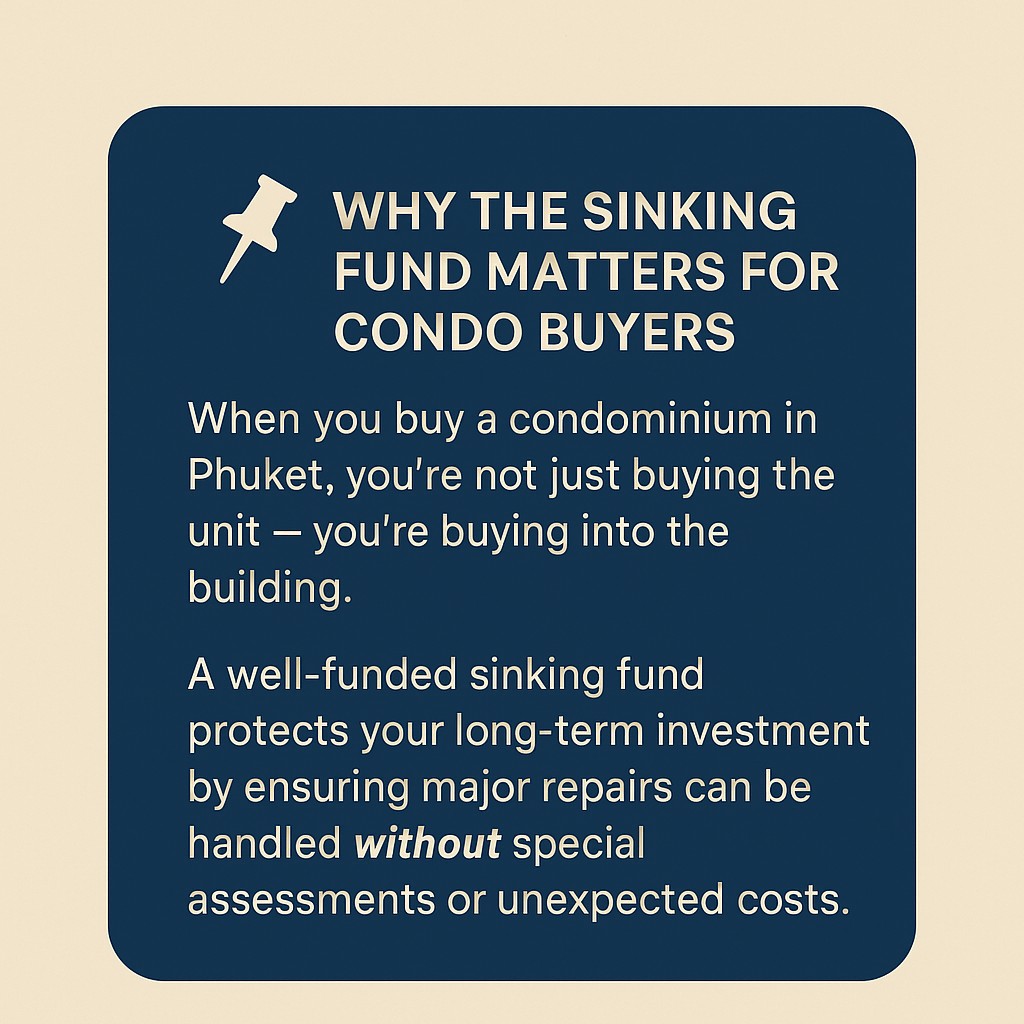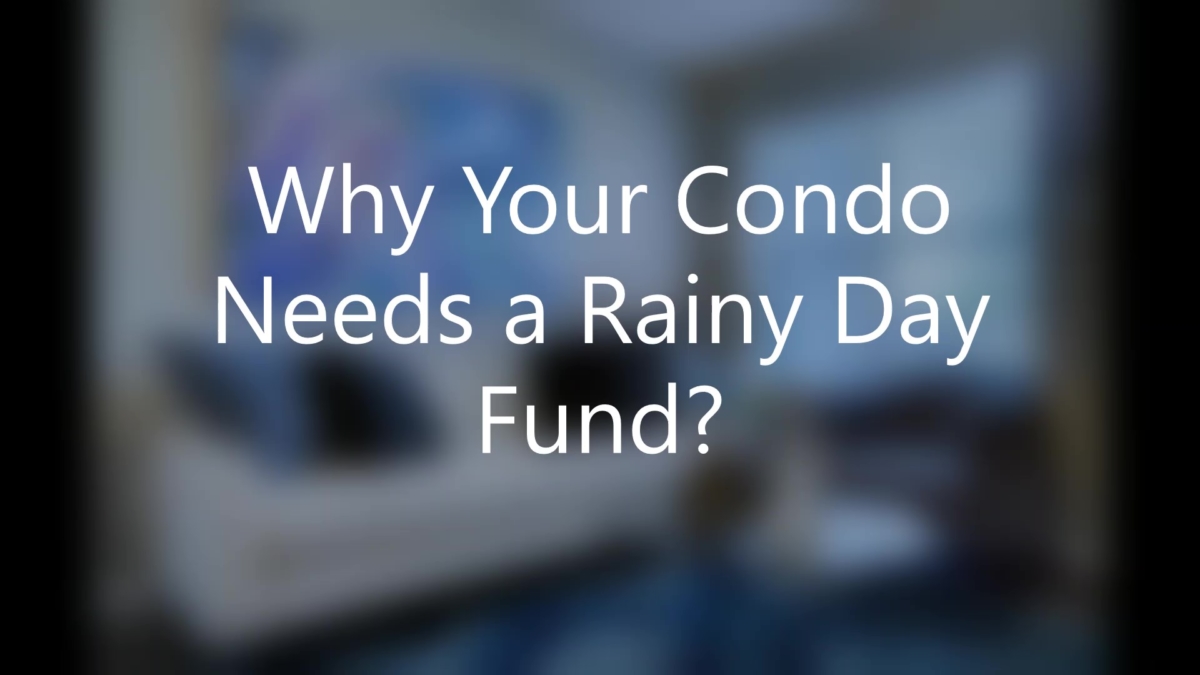The Phuket condo sinking fund plays a vital role in condominium ownership but is often misunderstood. Every unit owner contributes to this reserve, which finances major repairs, replacements, and upgrades in shared areas of the building. Knowing how the fund is calculated, managed, and applied is essential for anyone navigating Phuket’s condominium market.
What Is a Phuket Condo Sinking Fund?
In Phuket, a condo sinking fund is a one-time payment that every unit owner makes when purchasing a condominium. The fund is managed by the condominium juristic person on behalf of all co-owners and serves as a shared reserve. Its purpose is to cover major future expenses that go beyond everyday upkeep, including:
-
Replacing elevators or other large building systems.
-
Carrying out structural repairs to roofs, walls, or foundations.
-
Completing large-scale upgrades such as repainting exteriors or refurbishing shared facilities.
With a sinking fund in place, long-term building maintenance does not rely solely on monthly fees.
How the Sinking Fund Is Calculated
The amount each owner pays into the Phuket condo sinking fund is determined by clear, measurable factors:
-
Unit size – Larger units contribute more because fees are usually calculated per square metre.
-
Development scale – Projects with more shared facilities typically set higher contributions.
-
Construction quality – Luxury buildings often require larger reserves to maintain high standards of finishes and equipment.
The sinking fund is collected once at the time of purchase and cannot be refunded if the unit is later sold.
Example: If a sinking fund rate is set at THB 500 per square metre, a 60 sqm unit would require a one-time payment of THB 30,000. In high-end developments, this rate may rise to THB 1,000 per sqm or more.
Who Manages the Condo Sinking Fund?
The condominium juristic person manages each Phuket condo sinking fund on behalf of the co-owners. To protect transparency and fairness:
-
The fund stays in a dedicated bank account, separate from monthly maintenance fees.
-
The owners’ committee or a general meeting must approve any major use of the fund.
-
Annual financial reports are presented to co-owners, showing how money has been allocated.
This structure ensures the sinking fund supports only genuine long-term repair and replacement projects, not day-to-day expenses.

Legal Framework of Condo Sinking Funds
The Condominium Act sets out the legal framework for every sinking fund in Phuket. Under this law:
-
All registered condominiums must establish and maintain a sinking fund.
-
Unit owners are required to contribute based on their share of the building.
-
In addition, the fund may only be spent on repairs or replacements that benefit all co-owners.
For more details, see the official English translation of the Condominium Act 2008 amendments provided by the Thai Government Department of Lands.
Common Misunderstandings About Phuket Condo Sinking Funds
Many new owners confuse the sinking fund with monthly common area fees. In reality:
-
Monthly fees cover day-to-day expenses such as cleaning, security, electricity for common areas, and staff salaries.
-
The sinking fund covers major, infrequent costs that would otherwise be impossible to fund through monthly collections alone.
Another misconception is that the sinking fund is an “extra profit” for developers or juristic persons. In fact, it is strictly reserved for the co-owners and must be used for their collective benefit.
Why Condo Sinking Funds Matters
Without a properly funded Phuket condo sinking fund, a building risks falling into disrepair. This can result in:
-
Reduced property values across all units.
-
Safety issues from poorly maintained systems.
-
Higher emergency costs if owners need to pay for sudden repairs.
A healthy sinking fund ensures that maintenance is planned, sustainable, and fairly distributed among all owners.
Summary: Condominium Sinking Funds
A condo sinking fund acts as a mandatory reserve that safeguards the long-term condition of condominium buildings. Owners contribute at the time of purchase, and the fund provides the resources needed for major repairs and replacements without sudden financial shocks. By design, it spreads costs fairly among co-owners, protects property value, and ensures the building remains safe and functional.
Before committing to any condominium, always ask clear questions about the sinking fund, such as its current balance, planned projects, and financial transparency, so you understand how your building’s future maintenance is secured.
Key questions to always ask about the condo sinking fund:
• How much is currently in the sinking fund?
• What future repairs or upgrades are planned?
• Are any major projects scheduled in the next few years?
FAQ: Phuket Condo Sinking Fund
What is a condo sinking fund used for?
It covers major repairs or replacements in shared areas, such as elevators, roofs, and structural elements.
Do all condo owners in Phuket have to pay into the sinking fund?
Yes. Contributions are mandatory under the Condominium Act and are based on unit size.
Is the Phuket condo sinking fund refundable if I sell my condo?
No. The sinking fund contribution stays with the building for the benefit of all co-owners.
Who decides how the sinking fund is used?
The condominium juristic person and co-owners’ committee decide, with oversight from the owners at general meetings.
Can I get a refund of the sinking fund when I sell my condo?
No, sinking fund contributions are non-refundable. When you sell your condo, the payment stays with the building. The new owner takes over your unit but does not need to pay the sinking fund again.
Related Guides
Conclusion
The Phuket condo sinking fund is a safeguard for the long-term health of condominium buildings. By pooling resources upfront, it ensures that repairs and upgrades are carried out properly and fairly. For owners, clarity on how the fund works is a vital part of understanding their rights and responsibilities in Phuket’s condo market.
Understanding the Phuket condo sinking fund ensures you know exactly how your building is maintained and how costs are shared.
Disclaimer: The information contained in this article is provided for general informational purposes only and does not constitute legal, financial, or investment advice. While every effort has been made to ensure accuracy at the time of publication, property laws and regulations in Thailand are subject to change. Readers should always seek independent legal advice from a qualified Thai lawyer before making any property-related decision or transaction.


Social Contact